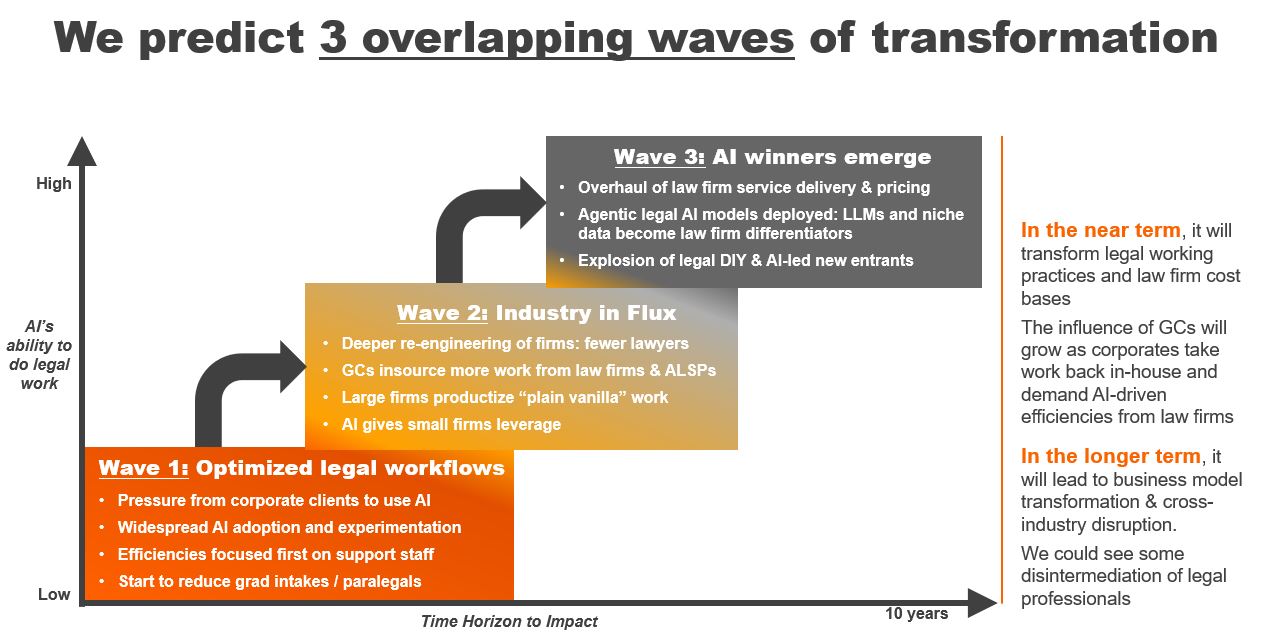Gen AI is game-changing technology, directly impacting the way legal work is done and the current law firm-client business model; and while much remains unsettled, within 10 years, Gen AI is likely to change corporate legal departments and law firms in profound and unique ways
Generative artificial intelligence (Gen AI) isn’t a futuristic technology — it’s here now, and it’s already impacting the legal industry in many ways.
Already, both corporate legal departments and law firms of all sizes have begun experimenting with Gen AI technology, both with public-facing tools such as ChatGPT, as well as more business-friendly tools such as Microsoft’s Copilot and legal industry-specific technologies. This experimentation has begun to give way to more discrete planning, as well as specific policies and procedures governing the use of Gen AI in the legal workplace.
This shouldn’t be a surprise. After all, just about everybody in legal knows that some sort of dramatic sea change is coming. Indeed, 70% of legal professionals said they believe AI and Gen AI will have a transformational or high impact on the legal profession within the next five years — more than any other trend, including the economy, regulation, and activities around environmental, social & governance (ESG) issues, according to the Thomson Reuters Future of Professionals Report, which also showed that Gen AI brings hope of a new efficient future but also fear of job replacement.
Both that hope and fear may be well-founded, as both the scope and pace of change may be greater than some in the legal industry anticipate. While some law firms are approaching Gen AI as an optional, nice-to-have technology, our research has found that change is likely to take place imminently. And within the next 10 years, the legal industry should expect wide-scale business model changes, as well as some disintermediation of lawyers in situations in which consumers eschew legal professionals altogether in favor of a technological option.
The most successful corporate legal departments and law firms won’t be the ones merely experimenting with Gen AI — they will be the ones preparing now for a legal industry future that will look a lot different in 2034 than it does today. That’s why we are embarking on a new blog series discussing Gen AI usage in the legal industry to help explore that future, laying out the scenarios we anticipate for the legal industry in both the immediate and mid-term future.
Our predictions for AI in the legal industry
To understand how the industry could be impacted by AI in the near and longer term, we garnered the views of Thomson Reuters’s technology and legal market experts, including members of TR Labs, who are at the cutting edge of legal AI research and development. We also interviewed a range of experts across industry and academia. Based on these discussions and other research recently conducted by Thomson Reuters, such as our Future of Professionals Survey, we have been able to make early predictions for how the legal market will evolve over the next decade.

Already, Gen AI has begun to make in-roads among law firms, corporate legal departments, and other legal service providers and technology companies. That impact will likely occur in three overlapping waves; however, the effect will not be linear. Some firms of course will move faster than others, while even within each firm progress could be diverse, with some practice areas with work that’s more susceptible to automation — such as real estate — radically transforming with AI faster than other practice areas, such as litigation.
This first wave we are already beginning to see now, with widespread AI adoption and experimentation occurring in corporate legal departments and law firms of all sizes. Over the next one-to-three years, the legal industry will increasingly gain access to trusted Gen AI tools from both large technology companies and legal technology providers, letting legal departments and law firms move from pure experimentation to putting AI plans into action. Especially at the beginning, this work will be focused on back-office functions and support staff. Law firms and their clients will begin considering how they can optimize their labor costs, reducing numbers of new associate hires and non-fee-earning staff.
The focus on non-billable work will not last for long, however, particularly as Gen AI technology advances to perform more complex tasks. Looking three-to-five years out, we begin to see changes to the legal business model emerge. AI will allow legal work to be done more efficiently, and corporate legal departments will put increasing pressure on law firms and outside providers to deliver work faster. As less time is spent on legal tasks, the billable hour will no longer be the most cost-effective way to capture value, prompting firms to reimagine their billing models to better share in efficiency savings and capture the value that’s added through advanced technology.
Already, Gen AI has begun to make in-roads among law firms, corporate legal departments, and other legal service providers and technology companies.
In response, large law firms will seek to capture more revenue by deploying staff, including juniors, to higher value work. They may also use their new law or internal innovations teams to standardize repeatable work that might otherwise be unprofitable. Meanwhile, small- and midsize law firms will be able to use Gen AI to grow their practice without needing to hire more staff. Regardless of size, however, the point is that change is a must: The law firms that don’t adapt will not be able to keep up with the efficiencies gained by their peers.
Finally, extending the time horizon out five-to-ten years leads to greater automation of legal services — and, in some cases, partial or full disintermediation of the legal professional through AI. With Gen AI technology capable of tackling even more complex tasks, AI will be a primary driver of day-to-day legal tasks, with legal practitioners acting as supervisors and strategists. The result is a complete overhaul of not only how legal services are completed and billed, but also the mix of players in the legal arena that are most needed.
Tech-enabled services will allow some legal clients in both the public and corporate spheres to sometimes bypass law firms entirely, relying on technology to serve their legal needs. This means do-it-yourself (DIY) legal solutions for consumers and small legal business are poised to proliferate, increasing access to justice in an underserved market. For law firms to survive, they will need to learn how to blend AI with human expertise and relationships, perfecting their service delivery to compete with a clientele that is familiar with and fully expectant of AI-enabled expertise.
Gen AI’s rollout looks different based on organizational type
However, as noted above, not all parties in the legal industry will fully embrace Gen AI’s introduction, nor will the technology’s advancement affect everyone equally. Gen AI will impact differently sized corporate legal departments and law firms unevenly.
At the forefront of the market, corporate legal departments will purchase and access Gen AI in a way that could transform their structure and day-to-day work product. Gen AI usage will likely be enterprise-wide at many companies, with the legal function receiving the benefits of economies of scale and outside technology investment. As corporate legal departments continue to experience cost pressures, however, we anticipate a changing of internal roles within those departments, with fewer paralegal and junior roles as the tasks those roles usually handle become the first to get automated.
Corporate legal departments are also increasingly likely to expect lower costs from their outside providers in turn, particularly for low-stakes work — which in some cases means replacing current panel firms with lower-cost alternatives, including alternative legal service providers (ALSPs) or technology firms, meaning that these entities must embrace AI or risk losing out on work. And across the board, this client emphasis on costs could lead to a rise in alternative fee arrangements and a further diminishing of the billable hour.
This shift towards cost-cutting and a change of roles is likely to be mirrored across law firms of all sizes. Large law firms generally have greater technological capability and access to larger datasets, and many also have already established new law or internal innovation teams. Niche data could become a key law firm differentiator in the age of AI. Larger firms also may leverage their economies of scale to enable Gen AI-powered technology products that capture work that would not have been profitable without automation.
This shift towards cost-cutting and a change of roles is likely to be mirrored across law firms of all sizes.
Among midsize law firms, the same technology could be used to capture bigger-ticket work. By using AI to automate repeatable, labor-intensive tasks, midsize law firms should be able to take on more clients, including more complex clients, or perhaps cover more practice areas through an expanded scope. In this way, midsize law firms can bill themselves as low-cost alternatives for plain vanilla transactions or disputes.
At small law firms, Gen AI will be similarly used to automate some processes in order to win new business. This could impact small firms’ headcount — particularly the hiring of new paralegals and junior associates — as small law firms lawyers leverage Gen AI to automate processes that previously fell to these new hires. With time and cost saved, this would allow some smaller firms to take on more cases or even expand their practice into new areas, enabling these firms to grow their book of business without hiring additional staff. This could also help alleviate the access to justice problem that many consumers currently face.
All in all, there remains a lot of speculation around when and how Gen AI will influence the legal profession. Between the technology’s development, the industry’s reaction, and outside economic forces, there are a lot of different paths in legal that Gen AI could take.
Regardless of the exact path, it would be smart for law firms, corporate legal departments, ALSPs, and other legal industry players to begin plans for a potential future now, because it’s reasonable to believe that a Gen AI-impacted future will lead to profound change in the way people work.
In coming weeks, this series from the Thomson Reuters strategy team and the Thomson Reuters Institute will take a closer look at some of the individual practice and subject-area facets of those changes and what those professionals in the legal sphere should expect.







